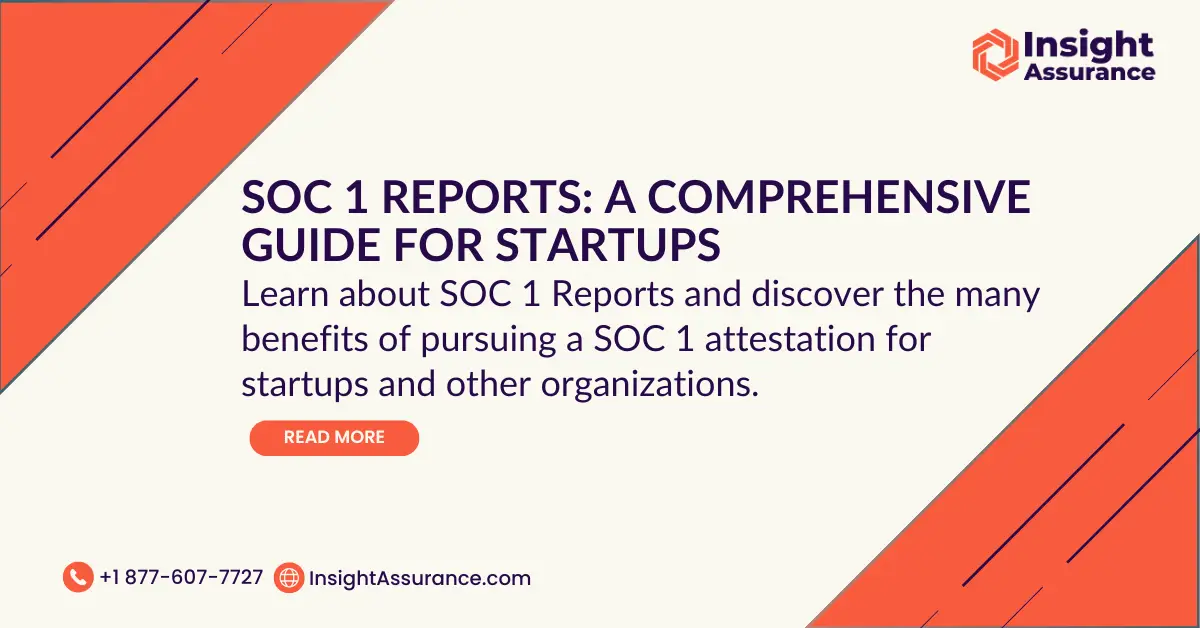In today’s interconnected world, the security of health information is no longer optional — it’s a business In the startup world, trust can be won or lost in an instant. Investors, partners, and enterprise clients want proof that an organization will handle sensitive financial data with care, and a SOC 1 report delivers that assurance. Demonstrating solid internal controls early helps young companies sidestep costly missteps and accelerates their path to market credibility.
Beyond reassurance, an affirmative SOC 1 report indicates a company has a structured framework for stronger operations. By aligning processes with attestation standards, a startup uncovers control gaps, streamlines financial reporting, and establishes a repeatable governance model. The result is sharper decision-making, smoother assessments, and a reputation for reliability that scales as the organization grows.
What Is a SOC 1 Report and Why Does It Matter for Startups?
A SOC 1 report is an independent attestation, performed under the American Institute of Certified Public Accountants (AICPA), regarding a service organization’s controls over financial reporting. The resulting SOC 1 report — available as a Type I snapshot or a more robust Type II assessment of operating effectiveness — can demonstrate that an organization has the necessary controls that impact clients’ financial reporting.
For startups, pursuing a SOC 1 report signals a disciplined approach to governance. Documented control activities, formalized risk assessment processes, and clearly defined responsibilities demonstrate that leadership prioritizes integrity in financial statements. This proactive stance streamlines future fundraising, supports board oversight, and reduces the likelihood of control-related surprises as the organization grows.
Equally important, a clean SOC 1 report elevates market perception. Enterprise prospects often require evidence of SOC compliance before sharing sensitive information or proceeding with long-term contracts. By presenting a Type II report that validates operating effectiveness over time, a startup shortens lengthy vendor reviews, differentiates itself from less-prepared competitors, and builds customer trust that translates to faster sales cycles and stronger renewals. But what are the tangible benefits of a SOC 1 report for ambitious startups?
The Key Benefits of SOC 1 Reports for Startups
A SOC 1 report can signal transparency that resonates with investors and customers alike. When a startup can prove operating effectiveness of controls, stakeholders gain confidence that its financial reporting is accurate and that it handles client data responsibly.
A rigorous SOC 1 assessment also uncovers process bottlenecks. By mapping every control to a specific risk, leadership gains clarity on where resources are over- or under-allocated, resulting in more efficient workflows and a stronger compliance posture.
The efficiencies extend far beyond the assessment itself, though. Here’s how following SOC 1 guidelines can streamline day-to-day operations:
- Consolidated documentation: By organizing policies, procedures, and evidence into one system, an organization can reduce time spent searching for critical information during future assessments.
- Automated control testing: Compliance automation tools monitor key activities in real time, decreasing manual effort and ensuring continuous adherence to adequate controls.
- Faster month-end close: Standardized reconciliations and approvals enable finance teams to finalize statements quickly, improving reporting accuracy and insight.
- Reduced vendor questionnaires: A Type II report answers most due-diligence questions related to financial controls up front, shortening security reviews and accelerating sales cycles.
- Lower remediation costs: Early identification of control gaps prevents minor issues from snowballing into costly, enterprise-wide fixes.
Beyond efficiency, following SOC 1 reporting standards strengthens risk management. The formal risk assessment process that AICPA requires forces startups to evaluate threats across systems, people, and third-party vendors. Documented mitigation not only safeguards sensitive information but also shows regulators and user entities that the organization takes industry standards seriously.
With these advantages in mind, the next logical question is how a resource-constrained startup can set up their operations to garner a positive SOC 1 assessment without derailing growth initiatives.
How Startups Can Navigate the SOC 1 Assessment Process
A formal readiness assessment is the fastest way to gauge how close — or how far — a startup is from a successful SOC 1 report. During this phase, control owners, IT leads, and finance teams collaborate with an external advisor. Together, they may map existing processes to attestation standards, uncover documentation gaps, and prioritize remediation tasks. By addressing weaknesses before the assessment, leadership avoids costly delays and sets realistic timelines for the overall SOC process.
Equally important is defining the scope of the engagement. Startups should pinpoint which systems, business units, and outsourced services directly influence financial reporting, then align those boundaries with broader organizational objectives. A tightly scoped SOC 1 assessment keeps costs down, targets the most material risks, and prevents teams from being overwhelmed by controls that fall outside the company’s service commitments.
After this, the heavy lifting can begin. This involves building and maintaining detailed process narratives, control matrices, and evidence repositories. Employee training follows, ensuring all parties, from engineers to accountants, understand control responsibilities, escalation paths, and documentation standards. Consistent upskilling not only prepares staff for interviews during the SOC examination but also embeds a culture of responsibility and professionalism that supports future assessments, such as SOC 2 or ISO 27001.
Engaging the Right Assessment Partner
CPA firms specializing in SOC 1 reports bring deep knowledge of AICPA attestation standards and can translate technical control language into clear, actionable feedback. Their experience shortens the learning curve for startups, helping teams anticipate requests and avoid common pitfalls that derail first-time assessments.
When selecting an assessment partner, startups should evaluate industry expertise, client references, technology-enabled workflows, and the firm’s capacity to meet aggressive timelines. Look for third-party firms who provide a dedicated engagement team, leverage secure evidence portals, and commit to milestone-based communication. These criteria increase assessment efficiency, reduce the review burden on internal resources, and support a smoother path to a clean Type II report.
Streamlining the Assessment Process
Modern compliance automation platforms can reduce manual evidence gathering. These platforms can do this efficiently by integrating directly with cloud infrastructure, ticketing tools, and financial systems. Furthermore, continuous monitoring flags control deviations early, giving startups ample time to remediate issues before they surface in the report.
Open, proactive communication with assessors is equally vital. Weekly touchpoints allow both sides to clarify control intent, discuss preliminary findings, and resolve deficiencies in real time. By collaboratively adjusting procedures or supplementing evidence, startups avoid last-minute surprises and strengthen operating effectiveness across the assessment period.
When the report is complete, attention turns to sustaining those hard-won controls. So, how can startups adhere to a SOC 1 framework as they scale up?
SOC 1 Over Time
A positive SOC 1 attestation is not the end of the story. An organization must then sustain operating effectiveness between assessments. Continuous monitoring — using dashboards, automated alerts, and routine control owner check-ins — helps detect and correct deviations in access management, change control (depending on the relevance to financial reporting), or financial reporting processes. This vigilance keeps evidence fresh and shortens preparation time for the next Type II report.
Regulatory expectations and industry best practices rarely stand still. Startups should assign ownership for tracking new attestation standards, client requirements, and emerging risks. By integrating forward-looking risk assessment sessions into quarterly governance meetings, leadership can update policies, refine control activities, and align the SOC scope with changing business objectives before gaps materialize.
Periodic assessments amplify these efforts. Internal audits or mini-readiness reviews every six months validate that controls function as designed, highlight documentation drift, and reinforce a culture of accountability. The insights gained help finance and IT teams fine-tune workflows, reduce assessment fatigue, and maintain the high level of assurance investors and user entities expect. Over time, this disciplined cadence lowers the cost of SOC 1-compatible operations, improves financial data integrity, and positions the organization for seamless expansions into SOC 2, ISO 27001, or other frameworks.
By solidifying a post-assessment strategy, startups preserve the competitive edge their SOC 1 report delivers, setting the stage to conclude insights on maximizing that advantage.
A SOC 1 Report Can Empower Your Startup
A SOC 1 report is a strategic asset that elevates trust, sharpens operational efficiency, and strengthens risk management. By validating that controls over financial reporting are adequately designed and functioning, startups exhibit maturity well beyond their years, paving the way for smoother fundraising rounds and quicker enterprise sales. The discipline gained from the SOC process also fosters a culture of continuous improvement, ensuring internal controls scale in step with rapid growth.
Ready to use a SOC 1 report as a catalyst for success? Schedule a consultation with Insight Assurance and discover how an experienced assessment partner can simplify your SOC 1 journey, reduce the burden on your team, and help you secure a Type II report that accelerates market confidence. Get in touch today to learn more.

